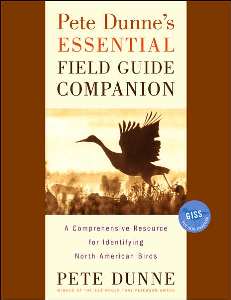Reviewed by Grant McCreary on December 15th, 2006.
This guide has absolutely no illustrations. No birds, no range maps. Zip. Nada. But if that’s the case, can it still be helpful for identification? You bet! As the title suggests, this is meant to be used in conjunction with a field guide. Dunne assumes that the field guide will have the necessary illustrations and range maps and thus this book need not dedicate any space to them. Instead, this book is filled with information and tips that you won’t find in any field guide. While plumage based field marks are included, the guide focuses more on GISS (General Impression of Size and Shape).
There is a great introduction which describes the philosophy behind the book and gives instructions on how the book is to be used. It also includes a fantastic brief overview and review of the current North American field guides. The bulk of the book is comprised of 691 species accounts, which includes all the regularly occurring species of the United States and Canada. Some vagrants and high arctic breeders that are unlikely to be encountered are not included.
The typical species account includes the following:
- Nickname/tagline – a species nickname as created by Dunne
- Status – abundance and residency (permanent resident, migrant, etc)
- Distribution – breeding and wintering locale, migration
- Habitat
- Cohabitants – other birds and animals likely to be found in its preferred habitat
- Movement/Migration – timing and sometimes routes
- Vagrancy index – a numerical value indicating how likely it is to be found outside its usual range
- Description – size, shape, plumage
- Behavior – feeding, interactions with other birds, tameness, responsiveness to tapes/pishing/etc (where applicable)
- Flight – flight characteristics and pertinent field marks
- Vocalizations – songs, calls, flight calls
- Pertinent Particulars – comments that don’t fit into one of the other categories, a summary, and/or comparison with other species
The accounts are very easy to read due to Dunne’s fantastic writing style. Any of them are worth reading even if you’re not looking for specific information about the species. Dunne is at once informative and humorous. Did you know that in addition to Wood Ducks and Pileated Woodpeckers, the cohabitants of the Ivory-billed Woodpecker also includes Lazarus?
This guide is now among the first references I turn to when faced with an identification issue or when preparing for encounters with new species. It undoubtedly belongs in the arsenal of every North American birder.
For more information visit Houghton Mifflin
Disclosure: I get a small commission for purchases made through links in this post.



Comment